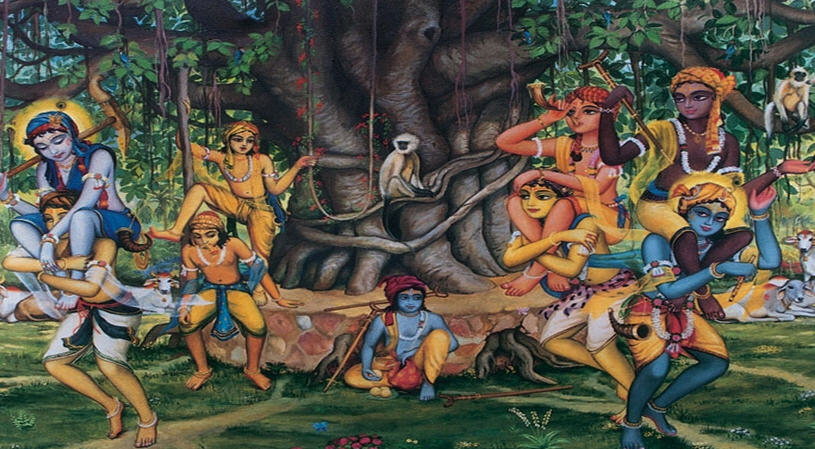
Bhandiravana, where Sri Krsna performed a variety of sweet pastimes, is prominent among the twelve forests. In this forest there are many pastime places to visit, such as Bhandiravata, Venu-kupa, Rasa-sthali Vamsivata, the place of wrestling, the temple of Sridama, Syama-talaiya, Chaheri-gaon and Agiyara-gaon. That place where all kinds of tattva-jnana and where pastimes that are filled with opulence (aisvarya) and sweetness (madhurya) manifest is called Bhandiravana. Some of these pastime places are described here.
Bhandiravata
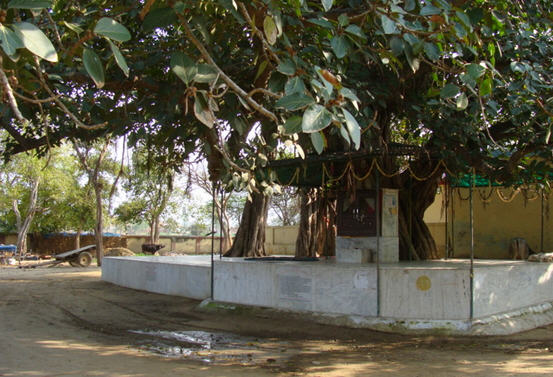
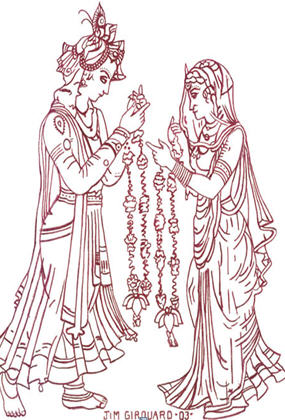
This vata (banyan) tree is famous in Bhandiravana as the site of many different pastimes of Sri Radha-Krsna Yugala. At the time of Sri Krsna’s manifest pastimes (prakata-lila), a huge banyan tree stood here full of long branches that spread in all directions. Nearby, Sri Yamuna made a sweet sound as she followed her meandering course. Sri Krsna, Baladeva and the sakhas would cross the river by walking on the branches of this tree. Male and female parrots, peacocks, peahens, cuckoos and papihas were always sitting singing on the tree’s profuse branches. They remained satisfied by eating its fruit. Deer, does and other forest animals drank the sweet water of the Yamuna and took rest in the cool, pleasant shade of the banyan tree. It was mostly to this Bhandiravata that Mother Yasoda and the mothers of the other cowherd boys used to send lunch with some gopas for their respective sons. While grazing the cows, Sri Krsna, Baladeva and the sakhas used to have the cows drink the water in the Yamuna and then freely graze on the lush, green grass of the forest. The boys themselves bathed and engaged in water sports in the Yamuna’s cool water. They would then sit in the shade under this banyan tree and eat the various tasty preparations sent by their mothers. Sri Krsna sat in the midst of them all, and the sakhas would sit around Him in thousands of rows that extended here and there. Each and every sakha, even if sitting at the back or far away, experienced that Sri Krsna was sitting right in front of him. Their eating was accompanied by laughing and joking, and they would play various games together. Brahma and other demigods in the sky became astonished to see their festive and joyful picnics. Brahma performed the gandharva marriage of Sri Radha- Krsna Yugala beneath this banyan tree. According to the Gargasamhita and Gita-govinda, Nanda Baba once took Sri Krsna to Bhandiravana to graze the cows. This forest was very attractively covered with the dense foliage of the tamala and kadamba trees and the lush creepers, and therefore it was only lit by scant sunrays. Suddenly, black clouds gathered from all directions and a raging rainstorm developed. Darkness pervaded. Nanda Baba became frightened of the bad omen and carefully hid Krishna on his lap. At that moment, the extraordinarily beautiful daughter of Vrsabhanu Maharaja, Sri Radhika, appeared there in the form of a young girl. She held Her hands out to Nanda Baba, indicating that She wanted to take Krsna with Her. The astonished Nanda Baba gave Sri Krsna to Her. Radhika then took Krsna to the inner part of Bhandiravana under the shelter of Bhandiravata. Here Sri Krsna manifested Himself as a beautiful youth who bewilders even the mind of Cupid. Meawhile, Lalita, Visakha and the other sakhis also appeared here with Lord Brahma. Knowing the desire of Kisora-Kisori,Brahma performed Their gandharva wedding by reciting Vedic mantras. Srimati Radhika and Sri Krsna exchanged beautiful flower garlands. The delighted sakhis sang wedding songs as the demigods showered flowers from the sky. While everyone looked on, Brahma left that place. The sakhis also disappeared, and Krsna again assumed the form of a small boy. Srimati Radhika took Krsna by hand and returned to Nanda Baba, who was stood waiting for Him. Meanwhile, the clouds dispersed and the storm abated. Nanda Baba now returned with Krsna to his Nanda-Vraja. To commemorate this pastime, a marriage platform is erected here and close by is also a temple of Sri Sri Radha Bhandirbihari, where deity of Krishna is applying vermilion on Radharani’s hair.


The following incident also took place here in Bhandiravana. One summer’s day, Sri Krsna and the sakhas brought the cows to drink water at the Yamuna and then let them graze freely. The boys became so absorbed in their delightful picnic that they were unaware that their cows had wandered off. The cows made their way to the completely parched Munjavana, through which even elephants could not force their way. It was the month of Jestha (May–June), and the blazing sun scorched the sand. The cows could not find shade anywhere, and had forgotten the pathway out of this wild munja forest. Dying of thirst, they began to cry out in distress. The sakhas went to look for the cows without telling Krsna and Baladeva where they were going. Finally, they too arrived at the munja forest in the same dire condition as that of the cows.
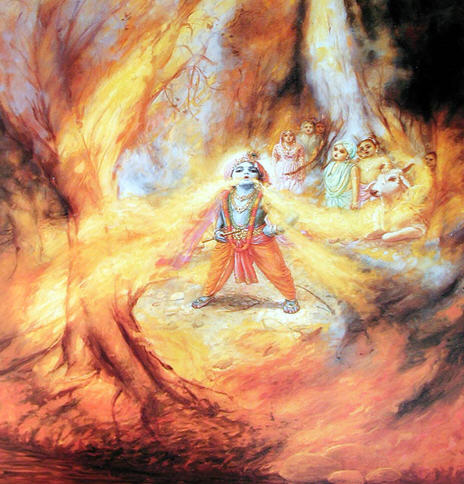
Meanwhile, the servants of the wicked Kamsa set Munjavana on fire, and within a moment the wind had spread it everywhere. The fire’s blazing flames surrounded the cows and cowherd boys, who saw no other means of rescue than to call out to Krsna. They did so, and Sri Krsna arrived immediately. Telling the sakhas to close their eyes, He swallowed the forest-fire within a second. Upon opening their eyes, the sakhas saw that they were again under the cooling shade of Bhandiravata, immersed in festive eating pastimes with Krsna and Baladeva, the cows grazing peacefully nearby. The distress of the forest-fire seemed like a dream. The place where Sri Krsna swallowed the forest fire is called Munjatavi or Isikatavi. The place where Krsna and the sakhas had festive picnics, and where, after Krsna swallowed the forest-fire, the sakhas again began to joke and laugh while eating and the cows happily chewed grass is called Bhandiravata. These pastimes are described in Srimad-Bhagavatam (10.19.12): tatheti militaksesu bhagavan agnim ulbanam pitva mukhena tana krcchrad yogadhiso vyamocayat “ ‘Okay,’ the boys said, and closed their eyes. Then Bhagavan, the controller of all mystic power, swallowed the terrible fire, thus saving the sakhas from the danger.”
The Killing of Pralambasura and Vatsasura
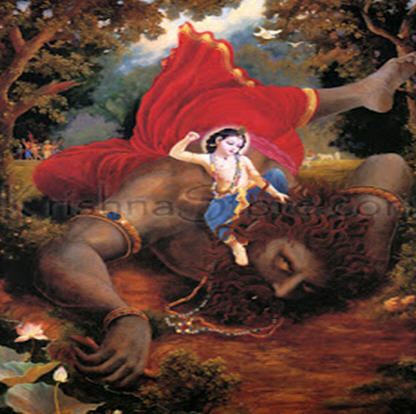
Bhandirvan is also the place which witnessed various playful games amongst Krishna and His cowherd boyfriends. Once while playing hide and seek, the cowherd boys had divided themselves into two teams and it was decided that the loosing team members would have to carry the winners on their backs. That day one of Kamsa’s evil associates, Pralambhasura entered their company with the plan of killing Krishna Balaram, in the disguise of a cowherd boy. Balaramji’s team turned out victorious. Having lost, Krishna carried Shridama while Pralambhasura was carrying Balaramji. Pralambhasura, running very fast, carried Balaramji to a distant place so as to tackle Him while He is all alone. However Balaramji became so heavy that he could no longer maintain his calmouflage and assumed his gigantic demoniac form. Balaramji promptly struck the demons head with His fist making his skull split apart and the demon immediately fell dead. Pralambasura was killed at the place called as Akshay vata. Pralambasura represents the dangerous demon of the inclination to enjoy the opposite sex and the inclination to enjoy profit, adoration and distinction. These desires to enjoy gross and subtle sex appear like our friend just as Pralambasura appeared as Krishna’s dear intimate lifelong friend. These desires promise us happiness, fun, excitement and fulfillment like a friend. But they cheat us. They ultimately kill the inclination for spiritual life and for Krishna consciousness from within our hearts. They kill the inclination to selflessly serve others and to serve God and ultimately make us selfishly motivated. So we must be very careful against them. On another occasion while Krishna Balaram were herding calves in Bhandirvan, a demon named Vatsasura disguised himself as a calf and started grazing with the other calves as if naive. Krishna understanding the evil intentions of Vatsasura, very softly came behind him, grabbed his hind legs and started whirling him around above His head circle after circle after circle until Vatsasura died out of diziness. All the Gopas celebrated killing of this demon however the Gopis in their transcendental humor accused Krishna of killing a calf and said that they won’t have anything to do with Krishna until He atones for this sin. So, Krishna created a well by pushing the tip of His flute into the earth and invoked all the Holy waters to enter that well. Only after taking His bath in that well was Krishna again accepted by the Gopis. This well is known as Venu kupa,which is still there near the Bhandirvata tree. Vatsasura represents the childish mentality by which a practicing devotee can be easily influenced due to bad association. A devotee of the Lord should be very simple; in fact he should be child like. But instead of being child like we become childish and foolishly get attracted to materialistic enjoyment because of bad association just like a child is sometimes cheated by rogues by offering some chocolates. One should become innocent and simple like a child if one wants to enter into the kingdom of God. But at the same time one must have discrimination. This combination makes a devotee very very pleasing to Krishna.
Venu-kupa

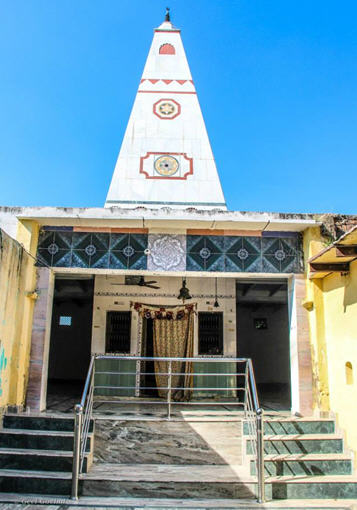
After killing Vatsasura, Sri Krsna met the gopis near Bhandiravata and boasted His strength. The gopis accused Krsna of killing a cow and forbade Him to touch them. Krsna said, “I did not kill a cow but a demon in the form of a calf.” The gopis, however, did not accept this. Krsna then inquired how His purity could be restored, and the gopis answered, “If You bathe in all the sacred rivers and ponds on the earth, You will again become pure and can touch us.” After hearing the words of the gopis, Krsna created a beautiful well (kupa) with His flute (venu) and summoned all of the earth’s sacred places to enter it. He bathed in that well and then met with the gopis. This well, known as Venu-kupa, is situated near Bhandiravata. By bathing in it, one obtains the same result as by taking bath at each and every sacred place. Even today, the women of Vraja worship this well on certain occasions. Those who do not have a child or whose child has died untimely make a vow to propitiate the deity here by their worship. Their hearts’ desires are then fulfilled.
The temple of Sri Baladeva
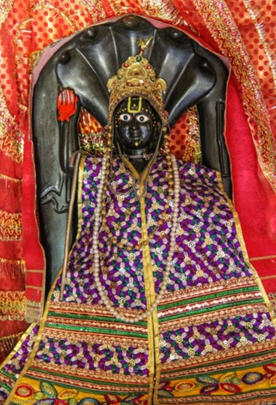
Sri Balabhadra, His younger brother Kanhaiya and the sakhas used to come to Bhandiravana to pasture the cows. Sri Balabhadra presides over the forests on the east side of the Yamuna, like Bhadravana, Bhandiravana, Baelvana, Gokula-Mahavana and Lohavana. Therefore, all these places have temples of Sri Baladeva. It is recommended that one visit the temple of Baladeva in Bhandiravana.
Rasa-sthali Vamsivata
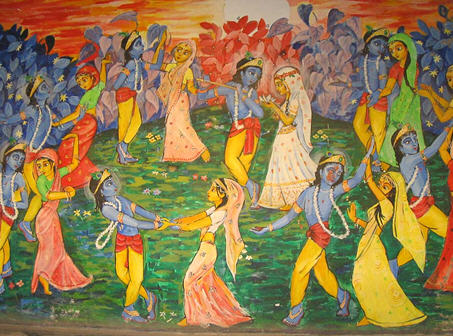
Sri Krsna’s place of rasa at Vamsivata is situated a short distance from Bhandiravata. This Vamsivata is a different place from the Vamsivata in Vrndavana. At the time of cow herding, Sri Krsna would climb this banyan tree and play His flute to call the cows. In this way, He would gather them and bring them all back home. Sometimes, on a beautiful, pleasant night, He would also call His beloved gopis from here – “Radhika, Lalita, Visakha!”. Upon their arrival, rasa-lila would unfold under this Vamsivata.

The temple of Sridama:
The temple of Sridama is beneath this Vamsivata. When Sri Krsna went to Mathura, Sridama Sakha was heart-broken. He went to this solitary Vamsivata, where he remembered Sri Krsna’s sweet pastimes, filling his heart with sorrow. Many days later, when Sri Krsna returned to Gokula after killing Dantavakra, He again met with Sridama here and took Sridama with Him. One can have darsana of Sridama in the temple here.
Syama-talaiya
This pond (talaiya) is situated near Vamsivata. When the gopis became thirsty during rasa, Sri Syamasundara made this pond with His flute and satisfied all the gopis with its luscious water. Nowadays, this pond lies in a completely dilapidated condition with very little water, but still, people take acamana here with faith.